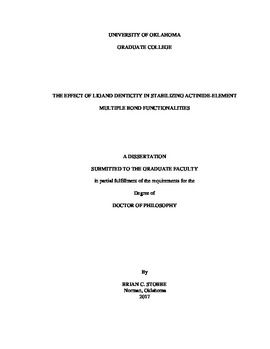| dc.description.abstract | Different synthetic approaches to the development of complexes with X-An=E and E=An=E functionalities (where An = U, Th) for use in studying the inverse trans influence (ITI) and the role f-orbitals play in early actinide bonding are expounded upon in this work. Chapter 1 gives a brief overview of the context of early actinide complexes in the nuclear fuel cycle, the grand challenges associated with understanding the inverse trans influence (ITI) and the participation of f-orbitals in bonding between actinides and main group elements.
Chapter 2 discusses the use of a κ1-ancillary anilido ligand [N(SiMe3)(3,5-(Me)2(C6H3)] to support actinide complexes to accommodate bulky U=E(R) moieties that can protect the reactive U=E bonds. This scaffold can be used to isolate tris(amido) halide (X)U[N(SiMe3)(3,5-(Me)2(C6H3)]3 (X = Cl, Br and I; complexes 2.3, 2.4 and 2.1 respectively) and homoleptic tetrakis(amido) complexes of uranium (complex 2.6), where a correlation between halogen electronegativity and 1H NMR chemical shift is observed. The identity of the alkali metal counterion (M) used in salt metathesis reactions of [M][N(SiMe3)(3,5-(Me)2(C6H3)] with AnX4 (An = U, Th; X = Cl, I) plays a significant role in the reactivity of the resultant halo tris(anilido) uranium species. All attempts at isolating U=E multiple bonds were unsuccessful and resulted in either no reaction or isolation of a disproportionation byproduct, U[N(SiMe3)(3,5-(Me)2(C6H3)]4.
Chapter 3 explores the use of a bulkier κ3-bis(diisopropylanilidomethyl) pyridine (BDPP) ligand, for stabilizing mid-valent uranium complexes. Previous studies with lanthanides and transition metals have shown this ligand scaffold to avoid non-innocent ligand-based reactivity. The BDPP ligand is shown to undergo non-innocent ligand based reactivity through alkylation at the 4-position of the BDPP pyridine backbone to generate a dihydropyridonate species (complex 3.1). All attempts at elucidating a plausible mechanism for this unwanted alkylation were unsuccessful; however, generality for this reaction is demonstrated through reactivity studies with [BDPP]Zr(NMe2)2.
Chapter 4 highlights the use of κ4-salen type Schiff base ligand (±)-trans-6,6’-diethoxy-2,2’-[cyclohexane-1,2-diylbis(nitrilomethanylylidene)]diphenol. This ligand system enables isolation of pseudo-trans dihalo actinide complexes [L]An(X)2(Solv)2 (X = Cl, Br, I; Solv = THF or pyridine; L = Schiff base ligand) (complexes 4.1, 4.1-(Py), 4.2, 4.2-(Py), 4.8, 4.9, and 4.10). Ligand innocence in [L]An(Cl)2(Solv)2 is maintained during reactions with both weak and strong nucleophiles and metal-based salt metathesis reactivity. This scaffold supports rare pseudo-trans diazido complexes [L]An(N3)2(Py) generated by reaction of [L]An(Cl)2(Solv)2 with excess NaN3 (complexes 4.3 and 4.4). Remarkably, this ligand framework can support the linear metallocene functionalities [L]An(Cp)2(1,4-dioxane) (complexes 4.6 and 4.7) upon reaction of [L]An(Cl)2(Solv)2 with 2 equiv. of NaCp, including the rare uranium linear metallocene (complex 4.6) and the first example of a thorium linear metallocene (complex 4.7). This ligand system also enables the preparation of a uranyl complex, [L]U(O)2(Py), through oxidation of the dichloro complexes with NaNO2 (complex 4.11).
Keywords: Inorganic Chemistry, Actinide Chemistry, Coordination Chemistry, Uranium / Thorium , | en_US |
